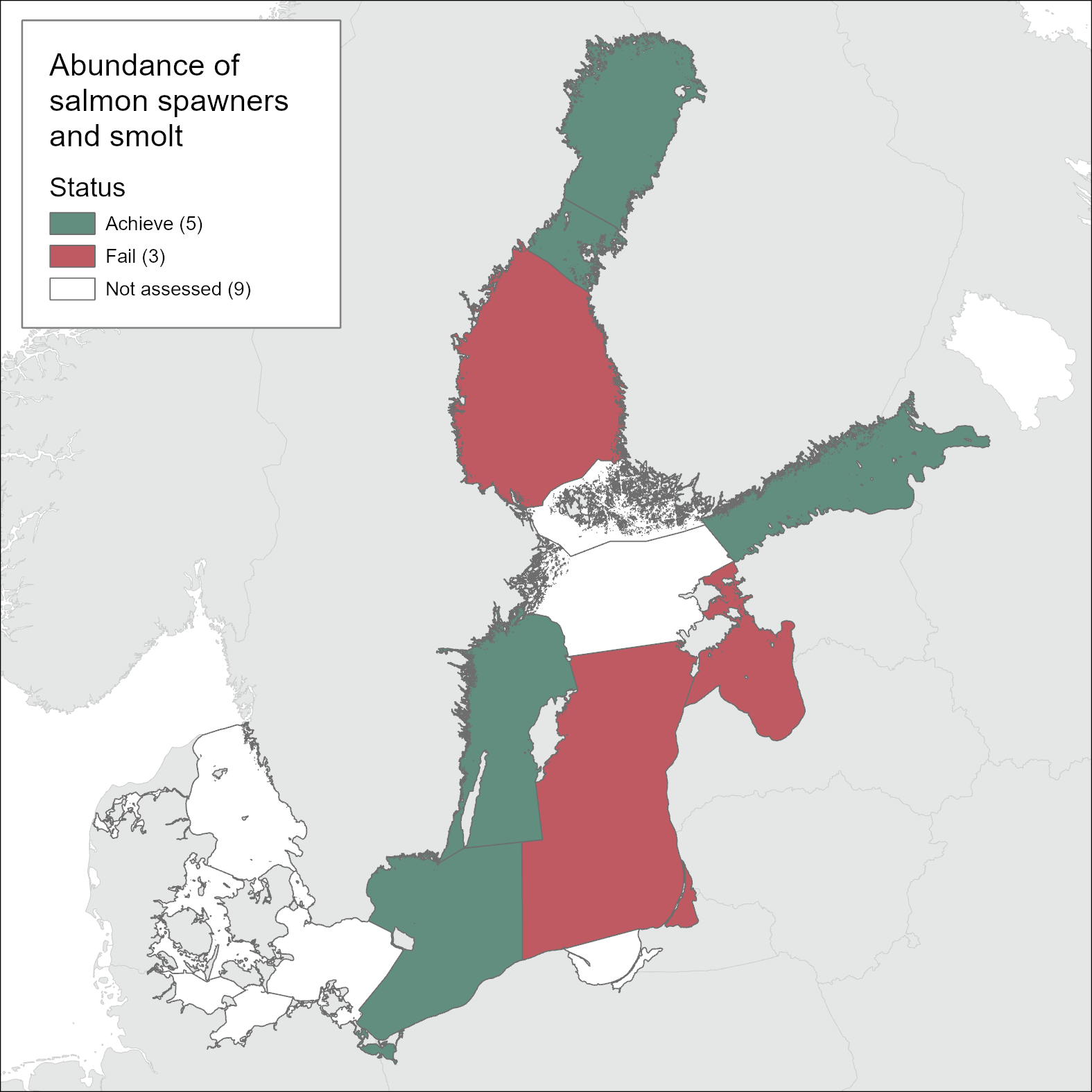 Salmon abundance
Salmon abundance
2. Relevance of the indicator
Salmon is a long-distance migratory large predatory fish species in the Baltic Sea ecosystem. Salmon abundance is mainly affected by commercial fishing at sea and by barriers in rivers preventing access to reproduction areas. This indicator has a linkage to the number of adult spawners ascending the rivers and, hence, indirectly to the commercial and recreational fishing pressure at the sea and in the river. The indicator also reflects the state of the ecosystem as smolt production is dependent on river connectivity (effect of dams) and the quality of spawning habitats.
2.1. Ecological relevance
Salmon is a top-predatory fish, and hence has an important role in regulating food webs and contributing to maintaining the general balance of ecosystems. Adult salmon mainly feed in the pelagic areas of Baltic Proper and also to some extent in the Bothnian Sea and the Gulf of Finland. Adult salmon feed nearly exclusively on sprat and herring, in the south mainly on sprat and towards the north increasingly on herring. Less frequently, salmon feed also on other species such as sticklebacks, sand-eels and crustaceans. Salmon does not cause a significant natural mortality to these stocks. Although salmon compete for these food resources with cod, it is a marginal rivalry since cod greatly outnumber salmon in terms of stock size.
Salmon is uniquely adapted to utilize low-productive, fast-flowing river habitat which is a good environment for reproduction, and to link this habitat with the pelagic sea habitat which offers good conditions for fast growth due to abundant prey species. Adult spawners ascend the spawning rivers after the feeding period and the number of smolts measured from the rivers reflect the abundance of the adult spawners and the success of reproduction. It is important to have a clear understanding of the status of the salmon populations in order to make informed assessments of the integrity of the food web.
Salmon play an important role in maintaining the balance in riverine food webs, both by harvesting invertebrate populations and also by serving as an important food source for other predatory species (ICES 2015).
2.2. Policy relevance
The core indicator of the Baltic salmon addresses the Baltic Sea Action Plan’s (BSAP 2021) Biodiversity segment’s goal (“Baltic Sea ecosystem is healthy and resilient”) and ecological objectives: ‘Viable populations of all native species’, ‘Natural distribution, occurrence and quality of habitats and associated communities’, ‘Functional, healthy and resilient food webs’.
The core indicator has relevance to the following specific BSAP actions:
- B15: ‘Develop and coordinate monitoring and assessment methods, where ecologically relevant, for specified representative coastal fish species, populations and communities, by 2023. Based on these assessment methods, to regularly assess the state of the coastal fish community through selected coastal fish species and groups, including threatened species, by at latest 2023. Based on the results of the assessment, develop and implement management measures with the ambition to maintain or improve the status of coastal fish species, including migratory species by 2027. Develop and implement habitat restoration plans of spawning sites for anadromous species in relevant rivers by 2025.’.
- B16: ‘To strengthen native strains and to reinstate migratory fish species: — By 2023 identify rivers where management measures for migratory fish species, including eel, would have the greatest positive impact. — Starting from 2023, in line with relevant international commitments, iteratively review and prioritize effective mitigation measures in the identified rivers and/or dams, including removal of dams and migration barriers where relevant and possible, especially in small waterways’.
The core indicator also addresses the following qualitative descriptors of the MSFD for determining good environmental status (Commission Decision (EU) 2017/848): Descriptor 1 Species groups of birds, mammals, reptiles, fish and cephalopods; Descriptor 4 Ecosystems, including food webs – Trophic guilds of an ecosystem; and to an extent Descriptor 3 Populations of all commercially-exploited fish and shellfish are within safe biological limits, exhibiting a population age and size distribution that is indicative of a healthy stock.
Salmon is listed as a species of community interest in the EU Habitats Directive (Annex II).
An overview of policy relevance is summarised in Table 1.
Table 1. Overview of policy relevance for this indicator.
| Baltic Sea Action Plan (BSAP) | Marine Strategy Framework Directive (MSFD) | |
| Fundamental link | Segment: Biodiversity
Goal: “Baltic Sea ecosystem is healthy and resilient”
|
Descriptor 1 Species groups of birds, mammals, reptiles, fish and cephalopods.
|
| Complementary link |
|
Descriptor 4 Ecosystems, including food webs – Trophic guilds of an ecosystem.
Descriptor 3 Populations of all commercially-exploited fish and shellfish are within safe biological limits, exhibiting a population age and size distribution that is indicative of a healthy stock. |
| Other relevant legislation: |
|
|
2.3. Relevance for other assessments
The status of biodiversity is assessed using several core indicators. Each indicator focuses on one important aspect of the complex issue. In addition to providing an indicator-based evaluation of the abundance of salmon spawners and smolt, this indicator contributes to the overall biodiversity assessment, along with the other biodiversity core indicators. The indicator is utilised in the integrated assessment of biodiversity (BEAT tool) under the state of the Baltic Sea report (HOLAS, including the thematic assessment of biodiversity).
3. Threshold values
The evaluation of environmental status is based on the smolt production in rivers with wild salmon stocks. The estimated smolt production is compared to an estimated potential smolt production capacity (PSPC) of rivers and the threshold value is defined as 75% of the PSPC (see Figure 2). This level of production roughly compares to a stock size at maximum sustainable yield (MSY) practically for all stocks.

Figure 2: The estimated smolt production is compared to an estimated potential smolt production capacity (PSPC) of rivers and the threshold value is to reach 75% of the PSPC.
The PSPC is estimated using a life history model developed by the International Council for the Exploration of the Sea Assessment Working Group on Baltic Salmon and Trout (ICES WGBAST). Some uncertainty in the method still exists, and thus the potential production capacity may be over-estimated for some river areas. Accordingly, the precautionary principle is applied when making estimates of the PSPC against the threshold value, and there is a small risk of falsely evaluating a river as being below the threshold value. Hence, when evaluating the status of an assessment unit that includes several rivers, a one-out-all-out (OOAO) approach is considered unsuitable, and a weighted evaluation is applied instead.
The adult spawners ascend the spawning rivers after the feeding period and the number of smolts (estimated based on the measured parr densities and smolt counts from the rivers) reflect the abundance of the adult spawners and the success of recruitment. The number of adult spawners is used as a supporting parameter in the indicator for areas where such monitoring data are available. Changes in the level of pressures affecting the salmon populations are expected to be noticeable, with a shorter time lag, in the number of spawners compared to the smolt production capacity, and thus any significant changes in trend are to be considered as early warning signals.
Mainly due to the use of the model and good availability of data from several areas, the confidence of the accuracy of the threshold is considered to be moderate to high.
Table 2. Threshold value(s) applied in the current evaluation.
| HELCOM Assessment unit name | Threshold value (number of smolts, thousands) |
| Bothnian Bay/ The Quark area | 2305 |
| Bothnian Sea | 3.5 |
| Western Main Basin (Western Gotland Basin and Bornholm Basin) | 37.5 |
| Eastern Main Basin (Eastern Gotland Basin and Gulf of Riga) | 41.4 |
| Gulf of Finland | 8.6 |
3.1. Setting the threshold value(s)
The estimated smolt production is compared to an estimated potential smolt production capacity (PSPC) of rivers and the threshold value is defined as 75% of the PSPC. This level of production was considered to roughly compare to a stock size at maximum sustainable yield (MSY) for most of the stocks.
The potential production capacity may be over-estimated for some river areas. Accordingly, there is a small risk of falsely evaluating a river as being below the threshold value. Hence, when evaluating the status of an assessment unit that includes several rivers, a one-out-all-out approach is considered unsuitable and a weighted evaluation is applied.
In 2021 ICES WGBAST estimated for the first time also the stock specific smolt productions giving maximum sustainable yield (MSY), making it possible to use those estimates as threshold values in future evaluations.
4. Results and discussion
The results of the indicator evaluation that underlie the key message map and information are provided below.
4.1. Status evaluation
Current status of salmon stocks
According to the current core indicator evaluation good status is achieved in the Bothnian Bay/The Quark area, Bothnian Sea and in the Western Main Basin (Western Gotland Basin and Bornholm Basin). In the Eastern Main Basin (Eastern Gotland Basin and Gulf of Riga) and Gulf of Finland, the status of salmon spawners and smolt is clearly below the threshold value.
The status of 41 salmon stock rivers have been evaluated by the ICES WGBAST. The results presented here are conclusions from ICES 2021 and aggregated by ICES evaluation area as presented in the area-specific graphs in Figure 3.
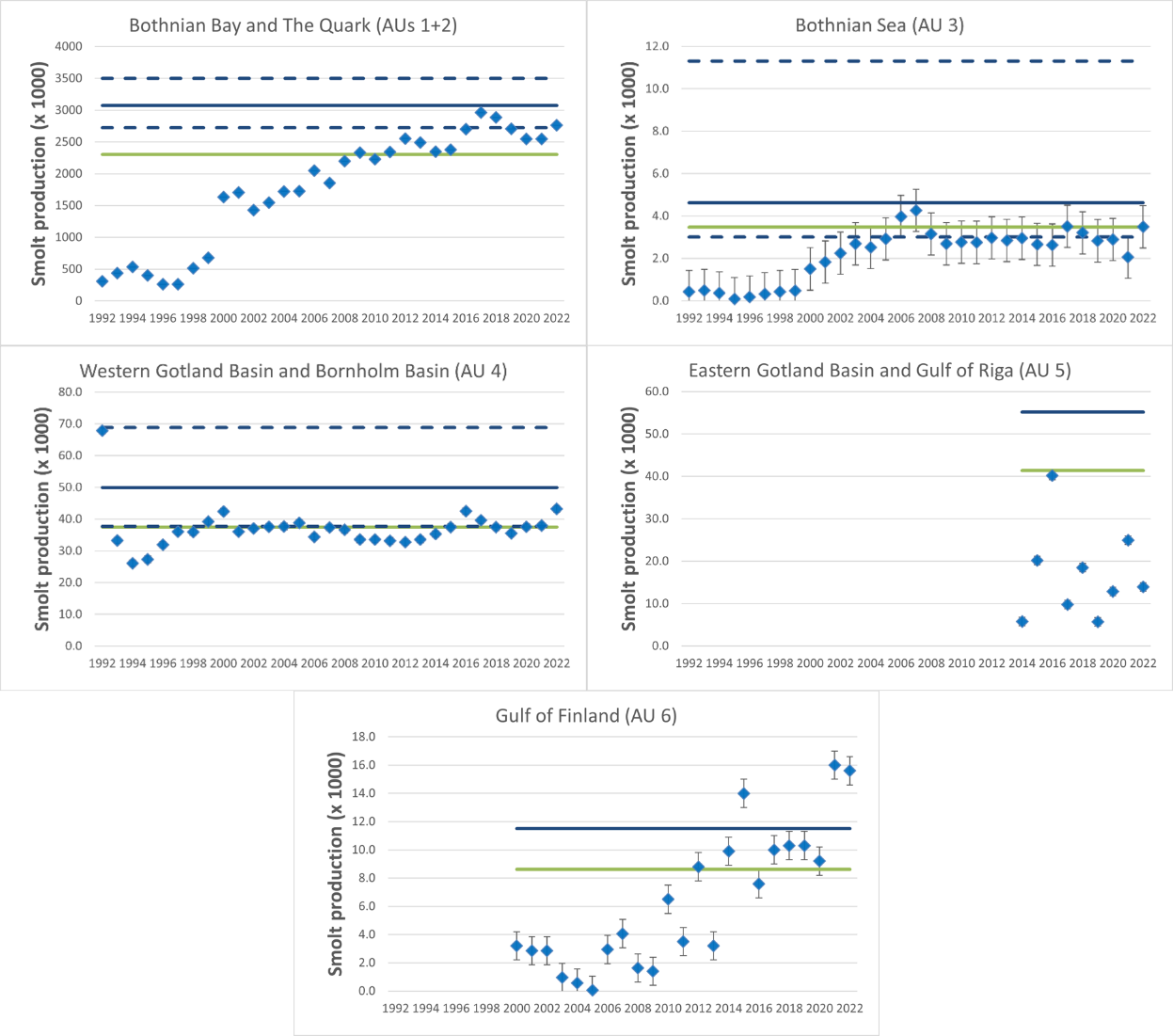
Figure 3: Status of salmon abundance in 1996–2022, note that 2021 and 2022 are model predictions), addressed by natural smolt production (median), in the assessment units. The Assessment units 5 and 6 (Eastern Main Basin and Gulf of Finland) were assessed without the model, based on field observations and expert judgment. The potential smolt production capacity (PSPC) is shown by the solid blue line (median) and the 90% probability interval of PSPC is shown by the dashed lines. The threshold value (green line) is 75% of the PSPC. Figure modified from ICES 2021. The status evaluation is based on 2020 since it is the final year with data (i.e. not modelled).
Of the 41 assessed salmon river stocks, 7 stocks (Tornionjoki, Simojoki, Kalixälven, Råneälven, Piteåälven, , Byskeälven, , Ume/, andTesteboån) in the in the Gulf of Bothnia, Mörrumsån in the Bornholm Basin, and 2 stocks (Kunda and Keila) in the Gulf of Finland likely, or very likely, reached 75% of the potential smolt production capacity (PSPC) and can be considered to achieve the threshold value (Figure 3).
There are large differences in the rate of the smolt production between the salmon river stocks. The situation in the northern Baltic rivers has improved significantly and many stocks have achieved the threshold, but most of the rivers in the southern Baltic are far from reaching their potential. However, the overall natural smolt production of 2.8 million smolts in 2020 has increased about six-fold since 1996 when it was less than 500,000 smolts. Estonian, Finnish, and Russian rivers in the Gulf of Finland evaluation area produced about 101,000 wild smolts.
The exploitation of salmon has decreased in the whole Baltic Sea area, which at least partly explains the improved status. The number of ascending adult spawners – counted only in some rivers – shows that the increase in smolt production is a result of more abundant spawning stock.
The status in the Eastern Gotland Basin and Gulf of Riga is a different story: the production is currently less than 30% of PSPC (Figure 3). The slow recovery of these stocks has been explained by overfishing, river water quality (pollution and eutrophication) and increased predation (in rivers). Also there is indication of increased poaching in some rivers.
Wild salmon stocks in the Gulf of Finland (three Estonian rivers, evaluation area 6) show a clear recovery but the status of mixed stocks (releases and natural reproduction occurring in parallel) is mostly at not good status.
Number of ascending adult spawners in the rivers of Bothnian Bay and the Quark
The number of ascending adult spawners is considered a supporting measure for evaluating the status in areas where monitoring data are available. The number of adult spawners has been monitored in some rivers using fish counters. The numbers have increased since the mid-1990s and a strong increase has taken place since 2012 (Figure 4). Older data from the mid-1970s indicate that the number of spawners began to increase in the 1990s and 2000s, coinciding with management measures taken at sea. Spawner estimates give supportive information parallel with smolt estimates, but are not directly used in the estimation of stock status.
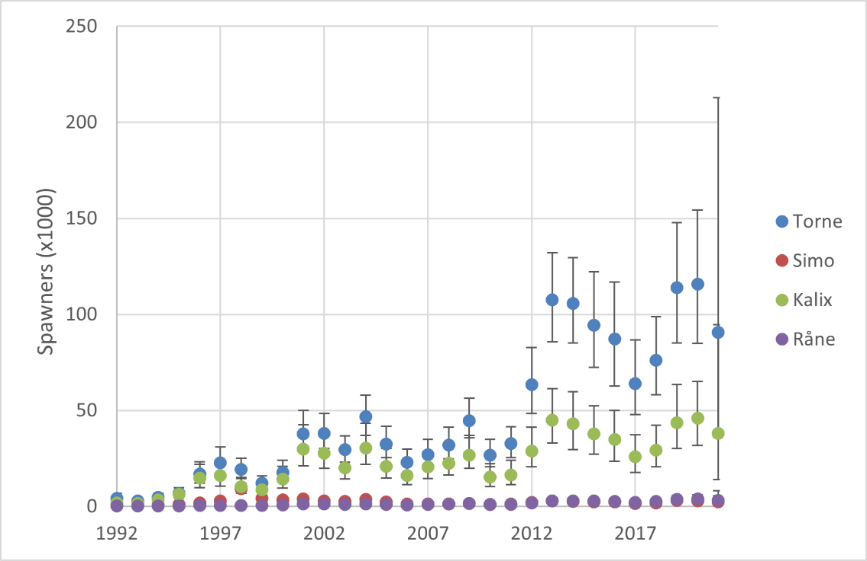
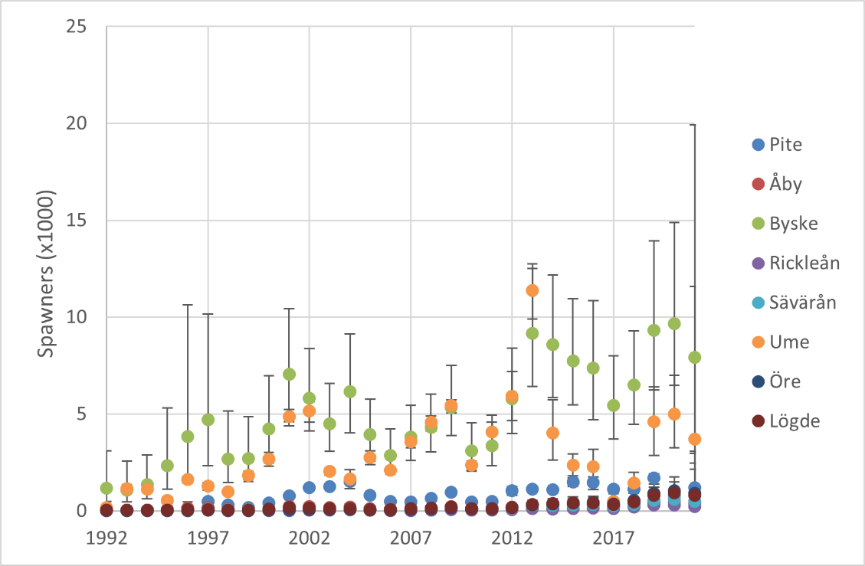
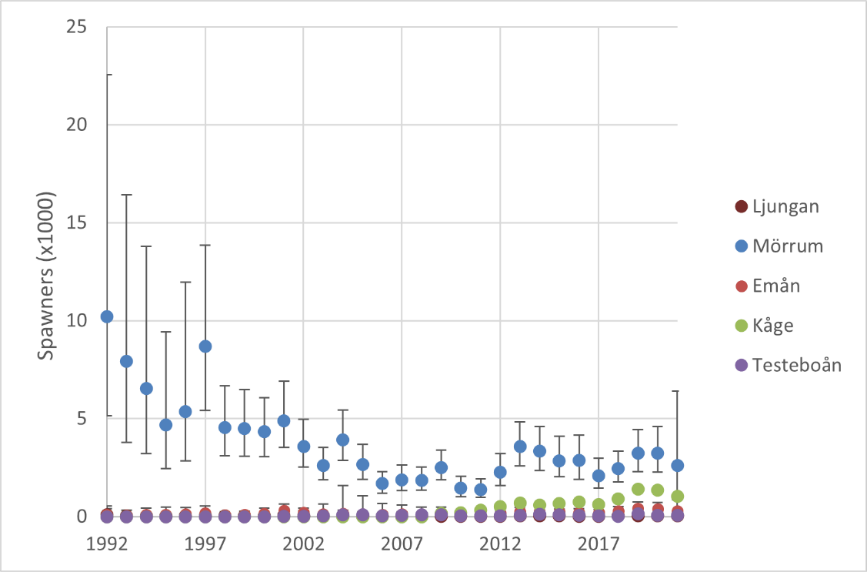
Figure 4. Estimated posterior distributions of the number of spawners (in thousands) by river in assessment units (evaluation areas) 1-4 during 1992–2021 (year 2021 is model predicted, median and 90% PI). Figure modified from ICES 2021.
4.2. Trends
Trends are provided above as they form a part of the evaluation process and comparisons between the current and previous assessment period are overviewed in the table below (Table 3).
4.3. Discussion text
The stock status of the largest river stocks dictates the general stock status in the Bothnian Bay and Quark area, where the status has maintained good. In the Bothnian Sea the river Ljungan is the only wild salmon river in the area. Ljungan has suffered from a low smolt production since the previous HOLAS assessment. Fishing has been prohibited in the river and the sea area outside the river mouth since 2017 which is expected to gradually improve the stock status in the next few years.
Stocks status in the Western Gotland Basin and Bornholm Basin has maintained good because of the good status of the river Mörrum stock.
The Eastern Gotland Basin and Gulf of Riga area consists of several small river stocks showing poor status, which apart from river Salaca show no signs of improvement. An EU regulation prohibiting commercial salmon fishery and allowing only fin clipped salmon to be landed in trolling fishery has been implemented in the southern Baltic Sea area (subdivisions 22 – 29S) in 2022, to protect and improve the salmon stocks in the area.
The status of wild salmon stocks in the Gulf of Finland has improved from the previous HOLAS assessment because of relatively high smolt production in the rivers Kunda and Keila (100% and 88% of PSPC respectably in 2020). In the river Vasalemma access to new spawning and rearing habitat has been opened as a result of the removal of a migration obstacle. The new reproduction area is currently populated and smolt production is increasing there (55% of PCPC). The increased natural smolt production of the mixed river Kymijoki (66 000 smolts) dictates the smolt production in the whole Gulf of Finland. The general status, however, is evaluated based on the three wild stocks in the area.
Table 3. Overview of status and comparison with previous assessment period.
| HELCOM Assessment unit name | Threshold value achieved/failed – HOLAS II | Threshold value achieved/failed – HOLAS 3 | Distinct trend between current and previous evaluation. | Description of outcomes, if pertinent. |
| Bothnian Bay | Achieve | Achieve | No change. Status dominantly driven by the largest reiver which is in good status. | The large Torne river achieved GES and is a major driver of good status in the stock for this region. |
| The Quark | Achieve | Achieve | ||
| Bothnian Sea | Achieve | Fail | Deterioration. The only wild stock (Ljungan) has suffered from low smolt production since the previous assessment period. | Ljungan stock, the only natural stock in the assessment area is in poor status due to low smolt production. GES is therefore not achieved. |
| Western Gotland Basin and Bornholm Basin | Achieve | Achieve | No change. The good status of the Mörrum stock maintains this. | The Mörrum stock is in good status and supports the achievement of GES. |
| Eastern Gotland Basin and Gulf of Riga | Fail | Fail | No change. Status has not improved in the river Salaca. | The river Salaca stock and thus the assessment unit fails to achieve GES. |
| Gulf of Finland | Fail | Achieve | Improvement. Status has changed to GES since the previous assessment period, in part due to high smolt production in the rivers Kunda and Keila. | High smolt production in the rivers Kunda and Keila contribute to the achievement of GES. |
5. Confidence
The estimation of smolt production and PSPC has been made using the evaluation model for 17 wild salmon stocks and by expert evaluation in 10 wild salmon stock. The modelled stocks are located in the Gulf of Bothnia and in southern Sweden whereas the expert evaluated stocks are located in the Baltic countries. In most cases, the model-based estimates are considered to give more accurate estimates of PSPC than expert evaluation and consequently there are regional differences in the confidence of indicator.
Currently, there is a full set of information (monitoring of spawning runs, smolt runs and river catches, and parr densities) only for a few river stocks in the Baltic Sea, with this type of monitoring taking place in Latvia, Estonia, Finland and Sweden. Apart of these so-called index-rivers, parr densities are followed using electrofishing surveys in all wild salmon rivers in the Baltic Sea area.
In general, the confidence of indicator status is higher for rivers in the Gulf of Bothnian than in the Baltic Proper and Gulf of Finland.
6. Drivers, Activities, and Pressures
Overall, salmon abundance is mainly affected by commercial and recreational fishing at sea and in rivers, by barriers to reproduction areas and by natural causes of mortality. However, it is not possible in all cases to determine exactly which human activities give rise to unsustainable levels of pressures on a salmon population. Typical stock specific pressures include fishery (legal and poaching) in the rivers and river mouths, access to spawning grounds, the quality of the river habitats and other factors such as hybridization with trout, negative effects of stocking, water regulations and diseases.
For salmon to successfully reproduce in rivers, the following environmental criteria must be met: sufficient quantity and quality of spawning grounds, access to those areas (no barriers, such as dams, in rivers) and efficient river fisheries management. In rivers, the most detrimental activities to salmon have been damming, dredging and channelizing of rivers for hydropower, log driving and agricultural purposes. Dams have been mainly constructed in the mid-20th century as a response to the growing demand for electricity. Also indirect impacts of human activities such as elevated nutrient and sediment loads from agriculture and forestry practices and from discharges of domestic sewage have adversely affected the water quality of Baltic salmon rivers.
In the middle of the 19th century wild salmon populations spawned in at least 60 rivers. Today the majority of Baltic rivers are not accessible or by other means unsuitable for salmon, but environmental degradation has been partly compensated for by releases of smolts and parr. Due to these measures, the current 58 Baltic salmon rivers are divided into four main categories: wild stock (28 rivers), mixed stock (13 rivers), reared (partly or completely) (18 rivers) and potential rivers (HELCOM 2011; ICES 2017). The wild salmon river stocks differ genetically from each other and therefore their well-being is of high importance from a population genetics point of view.
The salmon rivers have been ranked for conservation purposes according to the actual production in relation to the potential production (PSPC), so that the populations with the lowest ratio belong to the red list and those with the highest ratio to the green list (Figure 5). For more information about the criteria and classification, see HELCOM 2011.
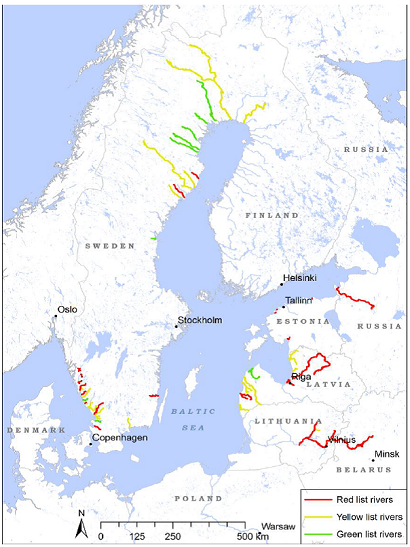
Figure 5. HELCOM SALAR salmon rivers according to their status (HELCOM 2011).
Salmon is a target species for intensive offshore, coastal and river fishing. Catches of salmon by commercial fishery at sea has decreased since the 1990s, but river fishing has stayed at a rather stable level (Figure 6).
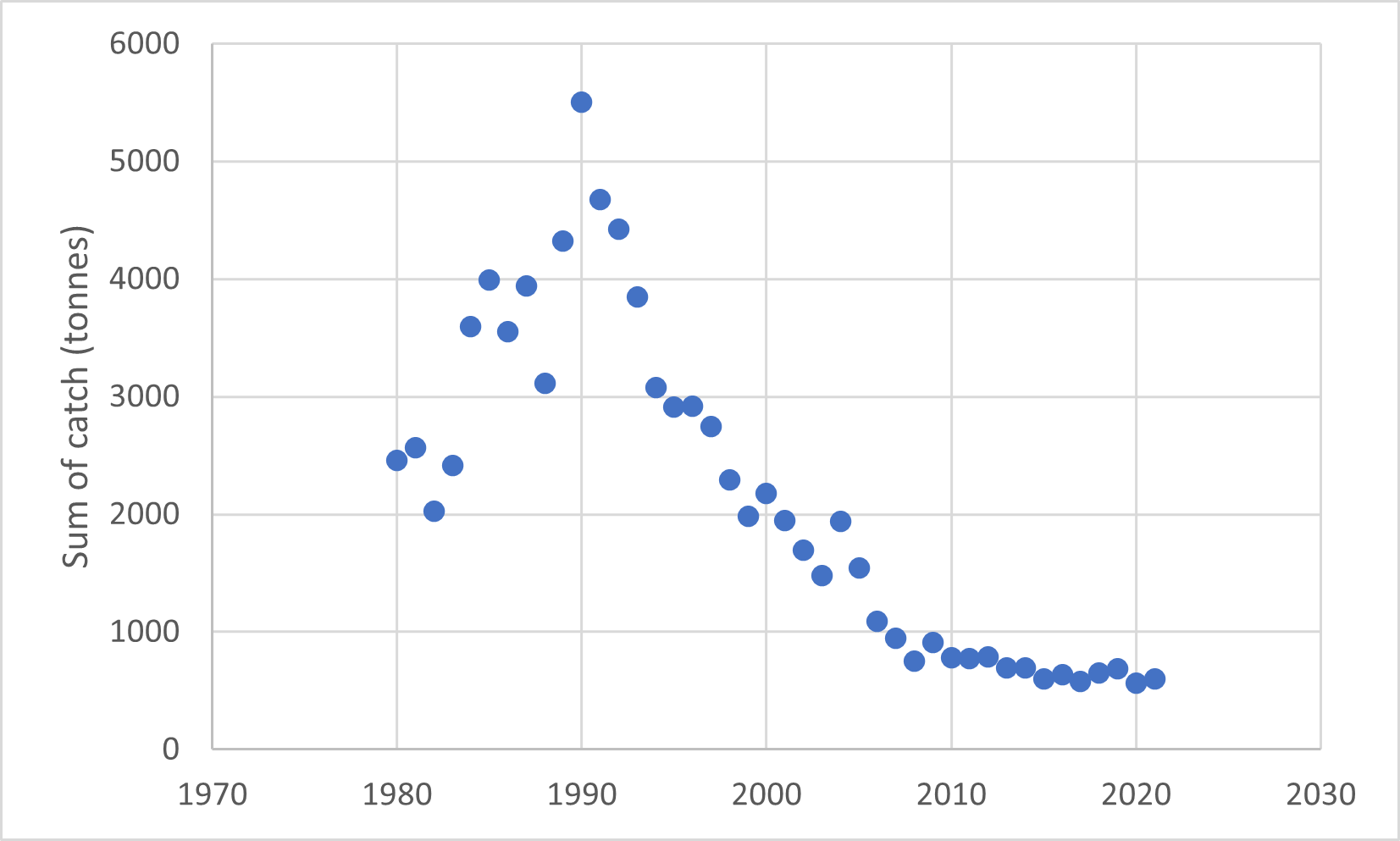
Figure 6. Sea catches of Baltic salmon. Based on ICES 2021. Data from 2021 represent a preliminary evaluation available to date.
The ban on driftnets in 2008 resulted in record low mortality in offshore fisheries, however, this low mortality was quickly compensated for by the increase of long-line fishery until 2011. In 2012 there was a substantial decline in long-line fishery and the harvest rate has since levelled off. Decline in the offshore fishing effort is partly the result of an act by Sweden and Finland to stop salmon fishing in the Baltic Proper from 2013 onwards and partly due to improved fisheries control which has decreased illegal fishing in the area. In 2019 the EU prohibited the sea trout fishing outside the 4 nautical mile in the Main Basin to prevent misreporting of salmon as sea trout in the open sea fisheries. In 2022 an EU regulation has been implemented prohibiting the commercial salmon fishery in subdivisions 22 – 29 south and allowing only fin clipped salmon to be landed in the open sea trolling fishery to protect and improve the salmon stocks in the eastern Gotland Basin and Guld of Riga. The coastal trapnet fishery declined from mid-1990s to mid-2000s, but has remained stable after that. For more information about fishing pressure on salmon, see ICES 2021.
Being at the top of the food chain, salmon accumulates harmful substances, i.e. various environmental toxins, which may have detrimental effects on their health.
Salmon are frequent prey species of grey seals, especially in the Gulf of Bothnia. The increasing population of grey seals is likely to consume more salmonids, which is expected to impact salmon and sea trout populations in a manner similar to fishing.
Post-smolt survival
Several physiological, behavioural and environmental factors affect salmon smolt survival (McCormick et al. 1998), including predation, feeding opportunities, smolt size and habitat conditions (Mäntyniemi et al. 2012; Saloniemi et al. 2004; Salminen et al. 1995; Russell et al. 2012). When smolts enter the sea, they need enough suitable food along their migration paths and must be able to avoid predation and by-catch in other fisheries in order to survive over the critical first year. Already during their downward river migration smolts may be predated by predatory fish or by birds (Jepsen et al. 1998) or at sea by seals (HELCOM 2012; Mäntyniemi et al. 2012). Sufficient quantity and composition of the food items at the sea (mainly herring and sprat) is also important (Karlsson et al. 1999; Mäntyniemi et al. 2012). A linkage between sea surface temperatures and smolt survival has also been observed (Salminen et. al 2008; Friedland et al. 2000). The factors affecting salmon smolt survival at sea are not yet fully understood and further research is needed (ICES 2012).
The post-smolt survival of salmon in the Baltic Sea has declined from 1990s to early 2000s, and has remained with a little variation at lower levels since 2005 (Figure 7). The decreased post-smolt survival has been explained by predation from the growing seal population, environmental change and increased by-catch of salmon in pelagic trawling fisheries targeted on other species in the Baltic Sea (ICES 2013, Mäntyniemi et al. 2012). The post-smolt survival of the southern stocks in evaluation areas 4 and 5 is not well known.

Figure 7. Post-smolt survival for wild (black) and hatchery-reared Baltic salmon stocks (grey). Boxplots show medians with 5%, 25%, 75% and 95% quantiles. ICES 2021.
Factors affecting smolt production
The main factors affecting smolt production are the number and size (i.e. bigger females produce more offspring) of adult spawners reproducing in the rivers (Figure 8). The smolt production capacity in rivers is restricted by space (area of suitable riverine habitat) and competitive behaviour of salmon parr; there being a maximum production level of smolts which is determined by the physical, chemical and biological characteristics of the environment.

Figure 8. Distributions for egg abundance (million), plotted against the smolt abundance (thousand) for the river Tornionjoki salmon stock. Blue dots present the posterior distributions of annual smolt and egg abundances, red curves indicate the distributions of stock-recruit relationship. ICES 2021.
The M74 syndrome, a reproduction disorder found in the sea-run Baltic salmon, caused major reductions in smolt production in the northern parts of the Baltic in the 1990s (the peak) after which the mortality decreased but increased again at the turn of the century (e.g. WGBAST 2021).
Table 4. Brief summary of relevant pressures and activities with relevance to the indicator.
| | General | MSFD Annex III, Table 2a |
| Strong link | Fishing of salmon as well as habitat quality degradation are the main pressures on salmon. | Biological disturbance.
Extraction of, or mortality/injury to, wild species (by commercial and recreational fishing and other activities). |
| Weak link | There might also be effects of hazardous substances on the health of salmon. | Potentially also:
Contamination by hazardous substances. Input of other substances (e.g. synthetic substances, non-synthetic substances, radionuclides) – diffuse sources, point sources, atmospheric deposition, acute events. |
7. Climate change and other factors
Several direct climate change effects, such as water temperature, sea ice changes, salinity and salt water inflows, and river run off are anticipated to have impacts on migratory fish populations and status (HELCOM and Baltic Earth, 2021). These direct parameters will also impact other factors that may result in indirect effects on migratory fish, for example via alterations in benthic habitats, changes in marine mammal populations or behaviour, success of Marine Protected Areas (MPAs, and changes in ecosystem function. In addition, resulting changes in human activities related to aquaculture, offshore wind farm development (or other energy requirements e.g. hydropower), as well as fisheries effort and practices may all alter pressures on migratory fish populations.
Migratory anadromous species, like salmon, return earlier to rivers after warm winter/spring. However, high water temperature in autumn and winter seems to lower the survival of salmon migrating back to the sea. Studies also indicate that reproduction of autumn-spawning migratory fish is expected to decrease with increasing temperatures, and spawning areas reduced if ice cover decreases further. The effects of some expected climate induced changes, e.g., shrinking ice cover and browner waters, on coastal and migratory fish stocks are poorly studied, but in may be that such pressures driver for example by terrestrial run off and increased discharges may have similar effects as those expected for coastal fish (HELCOM and Baltic Earth, 2021).
8. Conclusions
8.1 Future work or improvements needed
Establishing one index river in each evaluation area should be given high priority. Currently, only a few rivers in the Baltic provide the full set of information (monitoring of spawning runs, smolt runs and river catches, and parr densities) required of an index river. The collection of data concerning parr densities, smolt counts and number of spawners in these rivers should be given high priority. In index rivers, electrofishing surveys should preferably cover more sites than in non-index rivers and sites should be distributed over all parr rearing habitats of different quality in order to give representative estimates.
Electrofishing surveys should be carried out also in non-index salmon rivers, but it is not necessary for surveys to be carried out annually in every river – it would suffice with surveys carried out every second or third year for instance. However, monitoring in all non-index salmon rivers should be arranged so that each juvenile cohort is sampled at least once before smoltification. The decision of whether monitoring should be carried out in a particular year should not be influenced by expected changes in abundance of salmon. Smolt trapping may be carried out in a river for a couple of years and then moved to another river.
Further development of evaluations, possibly as a component of this indicator or a fully independent indicator, related to smolt survival could be valuable to explore.
9. Methodology
Monitoring data from each river are annually collated and processed so that updated estimates of smolt production and potential smolt production capacity (PSPC) are obtained. The procedure for obtaining the PSPC is described e.g. in ICES 2015.
The Baltic salmon river stocks are divided into six evaluation areas based on the biological and genetic characteristics of the stocks and associated management objectives (see Figure 9). Stocks of a particular evaluation area are assumed to exhibit similar migration patterns and to be subjected to the same fisheries, experience the same exploitation rates and be affected by management in the same ways. In addition, the genetic variability between stocks of an evaluation area is smaller than the genetic variability between stocks of different areas.
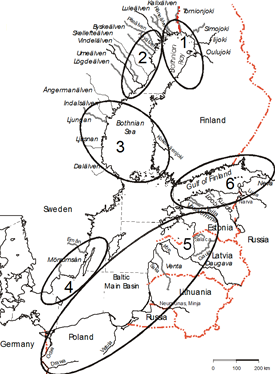
Figure 9. The evaluation areas defined based on migration patterns and genetic structure of the salmon populations.
The methodology and basis of the indicator evaluation is provided below.
9.1. Scale of assessment
This indicator mainly focusses on the spawning rivers and the spawning success of the adult fish returning from feeding migrations in the open sea areas. Due to the wide ranging feeding migrations of the adult fish, an approach has been selected where the monitoring data from rivers are used to evaluate status at the Baltic Sea sub-basins level, i.e. the HELCOM assessment unit scale 2 (as shown in Table 5). The assessment units are defined in the HELCOM Monitoring and Assessment Strategy Annex 4.
Table 5. Wild salmon rivers included in the ICES evaluation areas and HELCOM assessment units by Baltic Sea sub-basin (ICES 2017). Note: assessment units 5 and 6 currently also include some mixed rivers.
| Evaluation area | HELCOM assessment units | Rivers included |
| 1 | Bothnian Bay | Simojoki (FI), Torniojoki/Torneälven (FI/SE), Kalixälven (SE), Råneälven (SE) |
| 2 | Bothnian Bay, The Quark | Piteälven (SE), Åbyälven (SE), Byskeälven (SE), Rickleån (SE), Sävarån (SE), Ume/Vindelälven (SE), Öreälven (SE), Lögdeälven (SE), Kågeaäven (SE) |
| 3 | Bothnian Sea | Ljungan (SE), Testeboån (SE) |
| 4 | Western Baltic Proper | Emån (SE), Mörrumsån (SE) |
| 5 | Gulf of Riga, Eastern Baltic Proper | Pärnu (EE), Salaca (LV), Vitrupe (LV), Peterupe (LV), Gauja (LV), Irbe (LV), Uzava (LV), Saka (LV), Barta/Bartuva (LV/LT), Zeimena (LT) |
| 6 | Gulf of Finland | Kunda (EE), Keila (EE), Vasalemma (EE) |
9.2. Methodology applied
The indicator utilises data generated via the ICES WGBAST group and the methodologies to generate this data are provided in the regular reports, for example: ICES (2021) Baltic Salmon and Trout Assessment Working Group (WGBAST). ICES Scientific Reports. 3:26. 329 pp. https://doi.org/10.17895/ices.pub.7925.
9.3. Monitoring and reporting requirements
Monitoring methodology
Monitoring practices for salmon spawners and smolt are described on a general level in the HELCOM Monitoring Manual in the sub-programme: Migratory fish.
Specific guidelines are under development, with the aim to publish them in the Monitoring Manual.
Current monitoring
The monitoring activities relevant to the indicator that are currently carried out by HELCOM Contracting Parties are described in the HELCOM Monitoring Manual in the Monitoring Concepts table.
Sub-programme: Migratory fish Monitoring Concepts table
10. Data
The data and resulting data products (e.g. tables, figures and maps) available on the indicator web page can be used freely given that it is used appropriately and the source is cited.
Result: Abundance of salmon spawners and smolt
The data on salmon smolt production, number of spawners and other data from national monitoring is brought by the national representatives to the annual meeting of the ICES Working Group for Baltic Sea Salmon and Sea Trout (WGBAST). The data is documented in the reports of the group and forms the basis on which the model for salmon smolt production is run. There is currently no common database.
The stock data from Kattegat originates from the HELCOM SALAR project report (HELCOM 2011).
River surveys include parr density estimates, smolt trapping, monitoring of spawning runs and river catches.
Sea surveys include catch data, fishing effort data and catch composition estimates.
Joint river and sea surveys include tagging data (tagging in rivers, recaptures from sea and river fishery).
A table of parameters monitored in rivers by country is included in ICES 2017 (page 38).
11. Contributors
ICES Working Group for Baltic Salmon and Sea trout (WGBAST)
Results of the HELCOM SALAR project
12. Archive
This version of the HELCOM core indicator report was published in April 2023:
The current version of this indicator (including as a PDF) can be found on the HELCOM indicator web page.
Older versions of the indicator report are available:
Abundance of salmon spawners and smolt HELCOM core indicator 2018 (pdf)
HOLAS II Component – Core indicator report – web-based version July 2017 (pdf)
Core indicator report – web-based version October 2015 (pdf)
Extended core indicator report – outcome of CORESET II project (pdf)
13. References
European Commission (2008) Directive 2008/56/EC of the European Parliament and the Council of 17 June 2008 establishing a framework for community action in the field of marine environmental policy (Marine Strategy Framework Directive). Official Journal of the European Union L 164/19, 25.06.2008.
European Commission (2010) Commission decision of 1 September 2010 on criteria and methodological standards on good environmental status of marine waters (2010/477/EU). Official Journal of the European Union L 232/14, 2.9.2010.
European Commission (2017) Commission Decision of (EU) 2017/848 of 17 May 2017 laying down criteria and methodological standards on good environmental status of marine waters and specifications and standardized methods for monitoring and assessment, and repealing Decision 2010/477/EU. May 2017.
Friedland, K.D., Hansen, L.P., Dunkley D.A., MacLean, J. (2000) Linkage between ocean climate, post-smolt growth, and survival of Atlantic salmon (Salmo salar L.) in the North Sea area. ICES Journal of Marine Science 57: 419–429. Available at: http://icesjms.oxfordjournals.org/content/57/2/419.full.pdf+html.
HELCOM (2011) Salmon and Sea Trout Populations and Rivers in the Baltic Sea – HELCOM assessment of salmon (Salmo salar) and sea trout (Salmo trutta) populations and habitats in rivers flowing to the Baltic Sea. Baltic Sea Environment Proceedings No. 126A.
HELCOM (2012) Development of a set of core indicators: Interim report of the HELCOM CORESET project. PART B. Baltic Sea Environment Proceedings No. 129B. pp. 167-169.
HELCOM and Baltic Earth, 2021. Climate change in the Baltic Sea 2021 Fact Sheet.
ICES (2012) Report of the Baltic Salmon and Trout Assessment Working Group (WGBAST), 15–23 March 2012, Uppsala, Sweden. ICES 2012/ACOM: 08. 347 pp.
ICES (2013) Report of the Baltic Salmon and Trout Assessment Working Group (WGBAST), 3–12 March 2013, Tallinn, Estonia. ICES CM 2013/ACOM:08. 332 pp.
ICES (2017) Report of the Baltic Salmon and Trout Assessment Working Group (WGBAST), 27 March–4 April 2017, Gdańsk, Poland. ICES CM 2017/ACOM:10. 298 pp.
ICES (2021) Baltic Salmon and Trout Assessment Working Group (WGBAST). ICES Scientific Reports. 3:26. 329 pp. https://doi.org/10.17895/ices.pub.7925
Jepsen, N., Aarestrup, K., Økland, F., Rasmussen, G. (1998) Survival of radiotagged Atlantic salmon (Salmo salar L.) – and trout (Salmo trutta L.) smolts passing a reservoir during seaward migration. Hydrobiologia 371-372(0): 347-353.
Karlsson, L., Ikonen, E., Mitans, A., Hansson, S. (1999) The diet of salmon (Salmo salar) in the Baltic Sea and connections with the M74 Syndrome. Ambio 28 (1): 37-42.
Keinänen, M., Uddström, A., Mikkonen, J., Rytilahti, J., Juntunen, E.-P., Nikonen, S., Vuorinen, P. J. (2008) Itämeren lohen M74-oireyhtymä: Suomen jokien seurantatulokset kevääseen 2007 saakka. (In Finnish) Riista ja kalatalous – Selvityksiä 4/2008. 21 pp. Available at: http://www.rktl.fi/www/uploads/pdf/uudet%20julkaisut/selvityksia_4_2008.pdf.
McCormick, S., Hansen, L., Quinn, T., Saunders R. (1998) Movement, migration, and smolting of Atlantic salmon (Salmo salar). Can. J. Fish. Aquat. Sci. 22 (Suppl. 1): 77-92.
Mäntyniemi, S., Romakkaniemi, A., Dannewitz, J., Palm, S., Pakarinen, T., Pulkkinen, H., Gårdmark, A., Karlsson, O. (2012) Both predation and feeding opportunities may explain changes in survival of Baltic salmon post-smolts. ICES Journal of Marine Science 69 (9):1574-1579. doi: 10.1093/icesjms/fss088.
Russell, I., Aprahamian, M., Barry, J., Fiske, P., Ibbotson, A., Kennedy, R., Maclean, J., Moore, A., Otero, J., Potter T., Todd, C. (2012) The influence of the freshwater environment and the biological characteristics of Atlantic salmon smolts on their subsequent marine survival. ICES Journal of Marine Science 69 (9): 1563-1573. doi:10.1093/icesjms/fsr208.
Salminen, M., Kuikka, S., Erkamo, E. (1995) Annual variability in survival of sea-ranched Baltic salmon, Salmo salar L: significance of smolt size and marine conditions. Fisheries Management and Ecology 2 (3): 171-184.
Saloniemi, I., Jokikokko, E., Kallio-Nyberg, I., Jutila, E., Pasanen, P. (2004) Survival of reared and wild Atlantic salmon smolts: size matters more in bad years. ICES Journal of Marine Science 61: 782-787.
14. Other relevant resources
Bohlin, T., Hamrin, S., Heggberget, T.G., Rasmussen, G., Saltveit, S.J. (1989) Electrofishing — Theory and practice with special emphasis on salmonids. Hydrobiologia 173(1): 9-43. March 15, 1989.
ICES (2008) Report of the Workshop on Baltic Salmon Management Plan Request (WKBALSAL), 13–16 May 2008, ICES, Copenhagen, Denmark. ICES CM 2008/ACOM:55. 61 pp.
ICES (2014) Report of the Baltic Salmon and Trout Assessment Working Group (WGBAST), 26 March–2 April 2014, Aarhus, Denmark. ICES CM 2014/ACOM:08. 342 pp. Including Annex 4: Predicting maturation rates of Baltic salmon by using sea-surface temperature as a covariate. Pulkkinen, Dannewitz, White, Romakkaniemi.
Romakkaniemi, A., Karlsson, L., Jutila, E., Carlsson, U., Pakarinen, T. (2003) Development of wild Atlantic salmon stocks in the rivers of the northern Baltic Sea in response to management measures. ICES Journal of Marine Science 60: 329-342.
Uusitalo, L., Kuikka, S. and Romakkaniemi, A. (2005) Estimation of Atlantic salmon smolt carrying capacity of rivers using expert knowledge. ICES Journal of Marine Science 62: 708-722.
